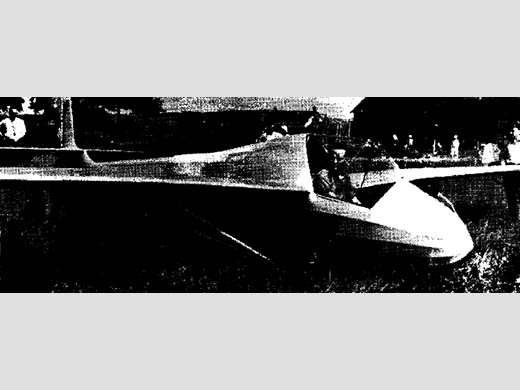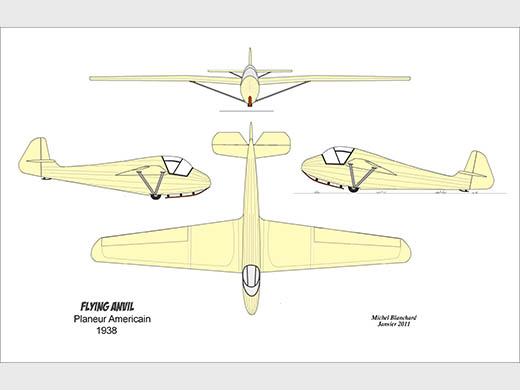
Carnegie Tech Flying Anvil
| DONNÉES GÉNÉRALES |
| Année du premier vol (ou de design, si seul projet) |
1938 |
| Pays | USA |
| Designer(s) | Carnegie Tech Gliding Club |
| Premier constructeur | Carnegie Tech Gliding Club |
| Type d'appareil | Planeur |
| Fonction | Entraînement |
| SPÉCIFICATIONS TECHNIQUES |
| Envergure | 10.97 m |
| Longueur | 6.7 m |
| Hauteur | -- |
| Allongement | 8.5 |
| Surface alaire | 16.95 m2 |
| Profil aile | NACA 2406 (emplanture) vers NACA 2412 (saumon). |
| Masse à vide | -- |
| Masse maxi | -- |
| Charge alaire | -- |
| Vitesse mini | 67 km/h |
| Vitesse maxi | -- |
| Finesse maxi | 17 à 92 km/h |
| Taux de chute mini | 1.2 m/s à 72 km/h |
| Nb sièges | 1 |
| Structure | Fuselage tubes acier soudés. Ailes bois et toile. |
AUTRES INFORMATIONS
| Constructeur(s) |
| ||||||
| Infos techniques | Masse à vide : 350 lbs. Charge utile : 200 lbs. Charge alaire 3,96 lbs/sq.ft. Ground handling and transportation were considered as major design features, because a club ship must make as many flights as possible to satisfy all the members. Wings and fuselage may be removed independently from the trailer. The horizontal tail surfaces fold into a vertical position for transportation, and are secured in flying trim with one bolt, a hinged elevator horn eliminating control rigging. Each wing attachment requires 5 bolts, the V-struts eliminating rigging except for aileron wire connections. The wing-fuselage juncture is well filleted, and features a 12 foot zipper to seal the gap. The ship is provided with zipper inspection openings to speed up routine checks. The wings are conventional two spar spruce construction. Doubled drag bracing from the strut point out provides exceptional torsional rigidity. Plywood covering to the front spar adds extra stiffness, and provides a smooth entering section. Unusually large ailerons, that require little deflection, do away with the need for differential operation. The fuselage is constructed of welded chrome-moly tubing to the rear of the wing, continuing with 1025 carbon steel. The nose is a rectangular section faired oval; the tail section is triangular, with faired top. The single 14-inch air-wheel is equipped with a self energizing brake. Cockpit provisions for storm flying include: a completely enclosed cover, excellent visibility, ample instrument panel, a seat-pack parachute, and plenty of room to get out in a hurry. The wing has straight taper in plan, but a change in section from NACA 2406 at the root to 2412 from the strut point out to the tip gives a slight gulled effect. The result is a thin root section, reducing interference drag, and an inherent aerodynamic washout which eliminates tip stalling with only 2-3 degrees of rigged washout. The stabilizer rides 20 inches above the ground in the landing position (to prevent elevator damage), and is 12 inches above the wing chord in flight. This places it in undisturbed air for elevator control in stalls. | ||||||
| Histoire résumée | Easy ground handling, careful aerodynamic design, and amazing "staying power" of the wings characterize the Carnegie Tech Glider Club's intermediate sailplane, the "Flying Anvil". The fuselage owes its strength to an original plan for a rugged training glider. Existing "Zoegling" wings were to be used, but a "brush pile landing" eliminated them, and the partially built fuselage was modified to use more efficient wings. A second major change was made when it was found that a set of streamlined wires would cost about $60.00. Hence, struts were considered more satisfactory. Preliminary stress analysis showed that the ship would be capable of taking very high loads, and specifications for gust and maneuvering laadings were raised to exceed any that might be found in storm flying or aerobatics. A Bureau of Air Commerce inspector remarked that the ship was stronger than many high-powered airplanes. Flights made at the Elmira contest indicated a speed range better than performance figures indicate. A landing was timed at slightly over 30 m.p.h. Test flights were unfortunately terminated by a convincing demonstration of the toughness of the ship. It will be repaired as soon as finances permit. | ||||||
| Liens personnalités | Pas de personnalité associée. | ||||||
| Remarques | Flying Anvil = enclume volante | ||||||
| Compléments docs |
SOURCES DOCUMENTAIRES
| Liens WEB | Pas de site référencé. |
| Livres | Pas de livre référencé. |
| Autres sources | The Carnegie Tech Flying Anvil, par H.H. Patton, Soaring Magazine, April 1938 |

Team J2mcL © 2003 -
- Pages optimisées pour Mozilla Firefox

